Climate Change and Nepal Tourism
VerifiedAdded on 2022/10/14
|8
|1849
|101
AI Summary
DETRIMENTAL IMPACT OF CLIMATE CHANGE DETRIMENTAL IMPACT OF CLIMATE CHANGE 6 6 DETRIMENTAL IMPACT OF CLIMATE CHANGE DETRIMENTAL IMPACT OF CLIMATE CHANGE Name of Student Name of University Author Note Introduction 2 Discussion 2 Impact on Himalaya 3 Different Risks to which Nepal Tourism is exposed 3 Recommendations 4 Conclusion 5 References 7 Introduction Climate change is a burning issue in the recent world scenario, which is affecting different environmental sectors (Schmidt, Ivanova and Schfer 2013). This paper aims to
Contribute Materials
Your contribution can guide someone’s learning journey. Share your
documents today.
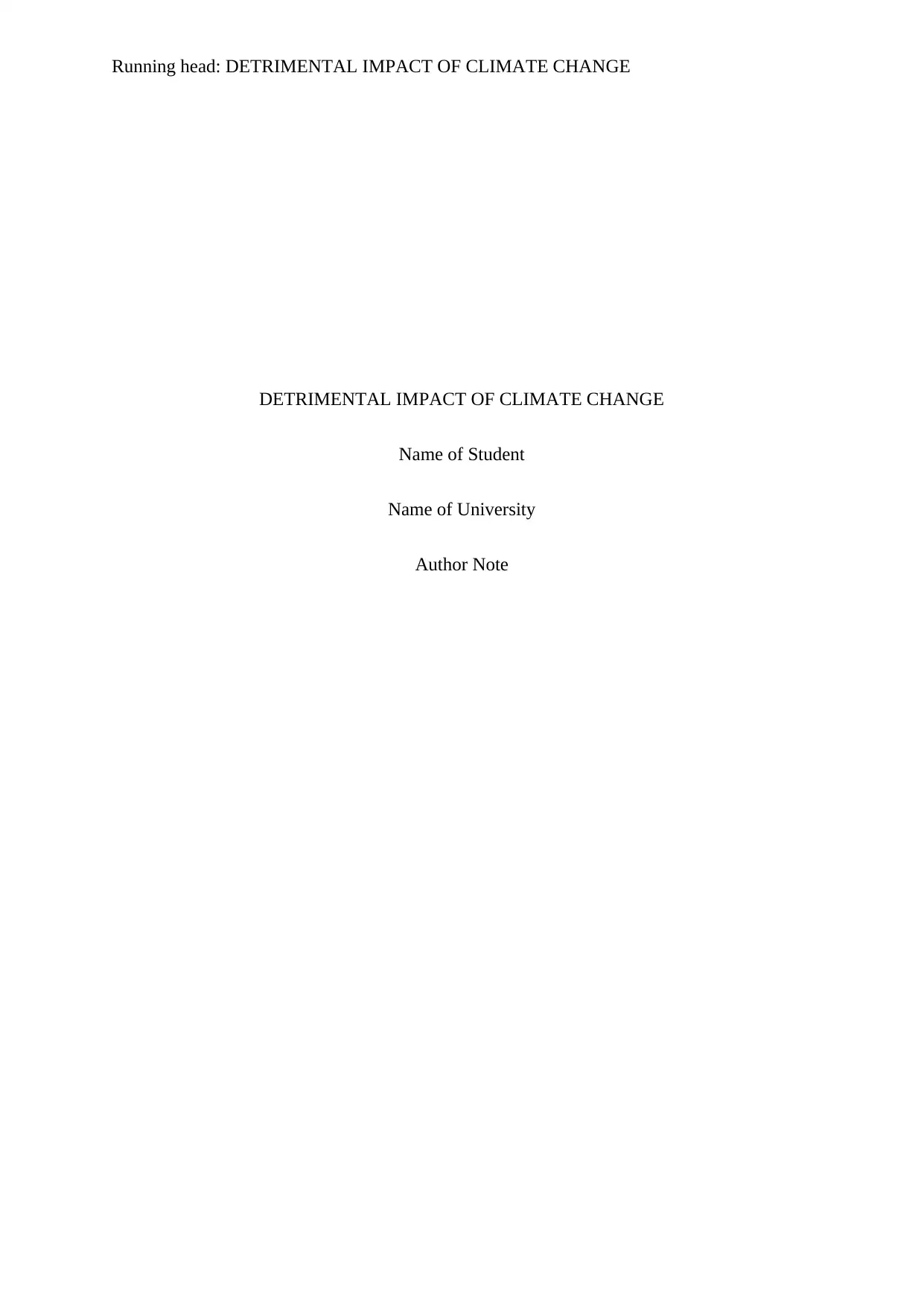
Running head: DETRIMENTAL IMPACT OF CLIMATE CHANGE
DETRIMENTAL IMPACT OF CLIMATE CHANGE
Name of Student
Name of University
Author Note
DETRIMENTAL IMPACT OF CLIMATE CHANGE
Name of Student
Name of University
Author Note
Secure Best Marks with AI Grader
Need help grading? Try our AI Grader for instant feedback on your assignments.
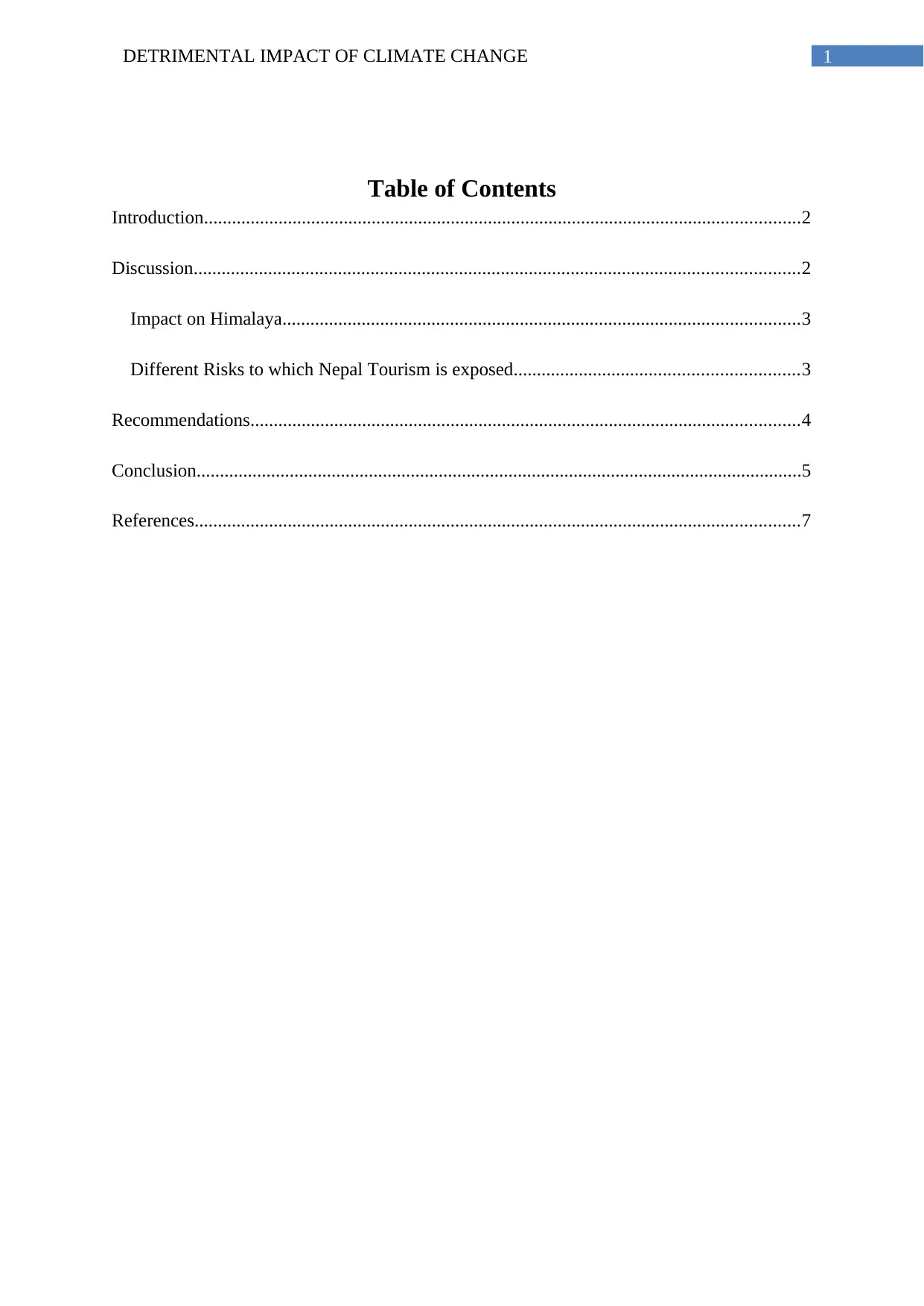
1DETRIMENTAL IMPACT OF CLIMATE CHANGE
Table of Contents
Introduction................................................................................................................................2
Discussion..................................................................................................................................2
Impact on Himalaya...............................................................................................................3
Different Risks to which Nepal Tourism is exposed.............................................................3
Recommendations......................................................................................................................4
Conclusion..................................................................................................................................5
References..................................................................................................................................7
Table of Contents
Introduction................................................................................................................................2
Discussion..................................................................................................................................2
Impact on Himalaya...............................................................................................................3
Different Risks to which Nepal Tourism is exposed.............................................................3
Recommendations......................................................................................................................4
Conclusion..................................................................................................................................5
References..................................................................................................................................7
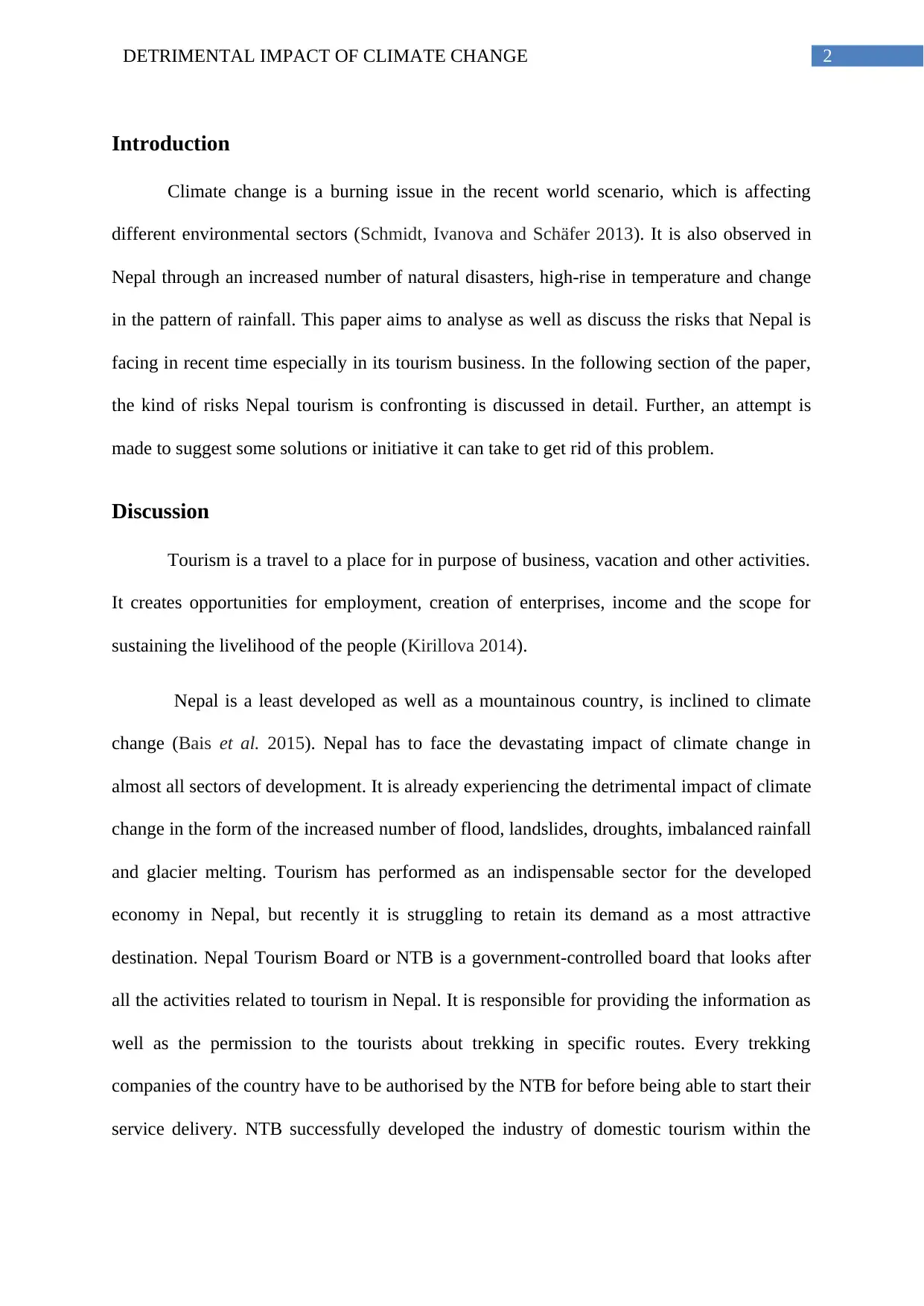
2DETRIMENTAL IMPACT OF CLIMATE CHANGE
Introduction
Climate change is a burning issue in the recent world scenario, which is affecting
different environmental sectors (Schmidt, Ivanova and Schäfer 2013). It is also observed in
Nepal through an increased number of natural disasters, high-rise in temperature and change
in the pattern of rainfall. This paper aims to analyse as well as discuss the risks that Nepal is
facing in recent time especially in its tourism business. In the following section of the paper,
the kind of risks Nepal tourism is confronting is discussed in detail. Further, an attempt is
made to suggest some solutions or initiative it can take to get rid of this problem.
Discussion
Tourism is a travel to a place for in purpose of business, vacation and other activities.
It creates opportunities for employment, creation of enterprises, income and the scope for
sustaining the livelihood of the people (Kirillova 2014).
Nepal is a least developed as well as a mountainous country, is inclined to climate
change (Bais et al. 2015). Nepal has to face the devastating impact of climate change in
almost all sectors of development. It is already experiencing the detrimental impact of climate
change in the form of the increased number of flood, landslides, droughts, imbalanced rainfall
and glacier melting. Tourism has performed as an indispensable sector for the developed
economy in Nepal, but recently it is struggling to retain its demand as a most attractive
destination. Nepal Tourism Board or NTB is a government-controlled board that looks after
all the activities related to tourism in Nepal. It is responsible for providing the information as
well as the permission to the tourists about trekking in specific routes. Every trekking
companies of the country have to be authorised by the NTB for before being able to start their
service delivery. NTB successfully developed the industry of domestic tourism within the
Introduction
Climate change is a burning issue in the recent world scenario, which is affecting
different environmental sectors (Schmidt, Ivanova and Schäfer 2013). It is also observed in
Nepal through an increased number of natural disasters, high-rise in temperature and change
in the pattern of rainfall. This paper aims to analyse as well as discuss the risks that Nepal is
facing in recent time especially in its tourism business. In the following section of the paper,
the kind of risks Nepal tourism is confronting is discussed in detail. Further, an attempt is
made to suggest some solutions or initiative it can take to get rid of this problem.
Discussion
Tourism is a travel to a place for in purpose of business, vacation and other activities.
It creates opportunities for employment, creation of enterprises, income and the scope for
sustaining the livelihood of the people (Kirillova 2014).
Nepal is a least developed as well as a mountainous country, is inclined to climate
change (Bais et al. 2015). Nepal has to face the devastating impact of climate change in
almost all sectors of development. It is already experiencing the detrimental impact of climate
change in the form of the increased number of flood, landslides, droughts, imbalanced rainfall
and glacier melting. Tourism has performed as an indispensable sector for the developed
economy in Nepal, but recently it is struggling to retain its demand as a most attractive
destination. Nepal Tourism Board or NTB is a government-controlled board that looks after
all the activities related to tourism in Nepal. It is responsible for providing the information as
well as the permission to the tourists about trekking in specific routes. Every trekking
companies of the country have to be authorised by the NTB for before being able to start their
service delivery. NTB successfully developed the industry of domestic tourism within the
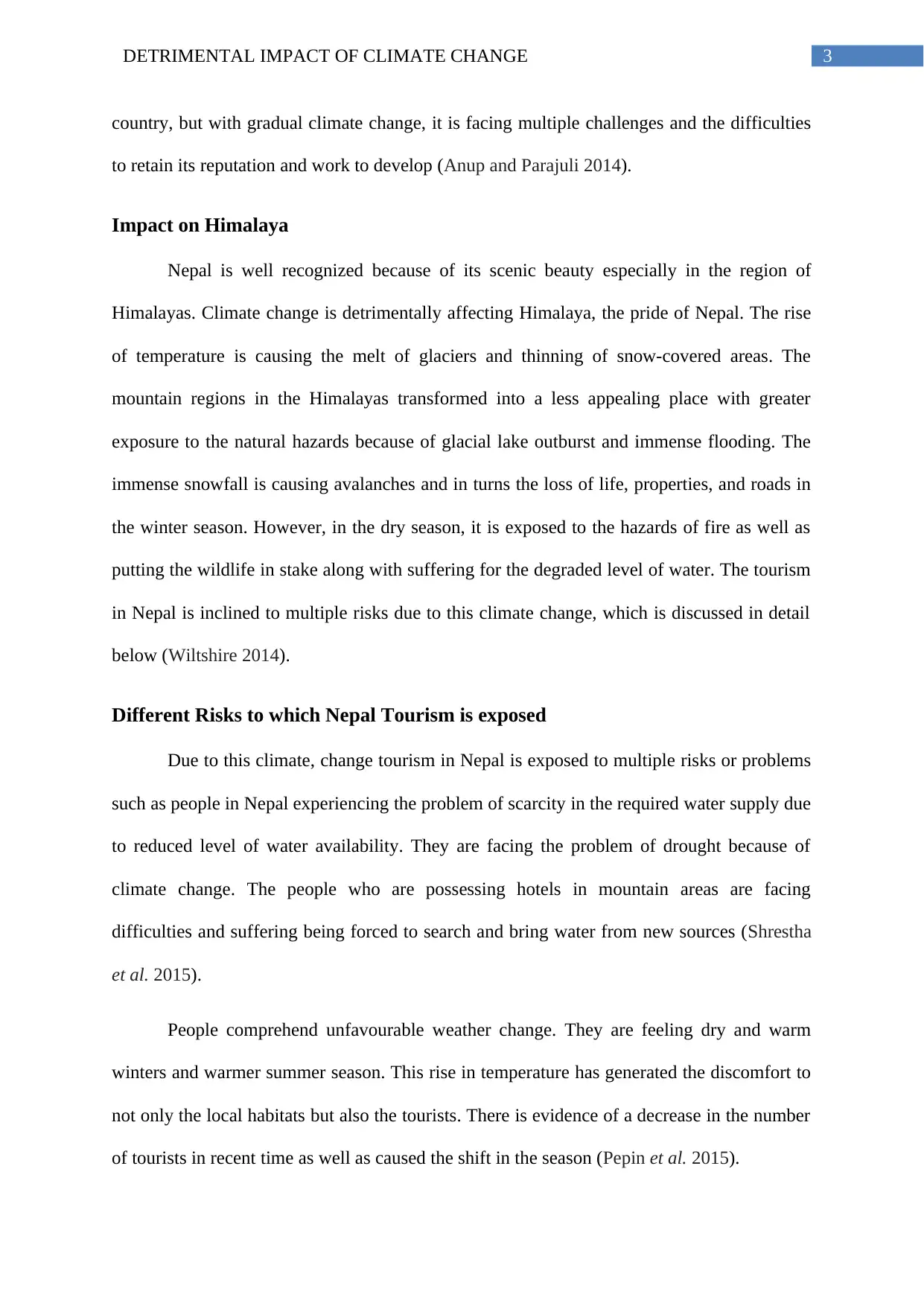
3DETRIMENTAL IMPACT OF CLIMATE CHANGE
country, but with gradual climate change, it is facing multiple challenges and the difficulties
to retain its reputation and work to develop (Anup and Parajuli 2014).
Impact on Himalaya
Nepal is well recognized because of its scenic beauty especially in the region of
Himalayas. Climate change is detrimentally affecting Himalaya, the pride of Nepal. The rise
of temperature is causing the melt of glaciers and thinning of snow-covered areas. The
mountain regions in the Himalayas transformed into a less appealing place with greater
exposure to the natural hazards because of glacial lake outburst and immense flooding. The
immense snowfall is causing avalanches and in turns the loss of life, properties, and roads in
the winter season. However, in the dry season, it is exposed to the hazards of fire as well as
putting the wildlife in stake along with suffering for the degraded level of water. The tourism
in Nepal is inclined to multiple risks due to this climate change, which is discussed in detail
below (Wiltshire 2014).
Different Risks to which Nepal Tourism is exposed
Due to this climate, change tourism in Nepal is exposed to multiple risks or problems
such as people in Nepal experiencing the problem of scarcity in the required water supply due
to reduced level of water availability. They are facing the problem of drought because of
climate change. The people who are possessing hotels in mountain areas are facing
difficulties and suffering being forced to search and bring water from new sources (Shrestha
et al. 2015).
People comprehend unfavourable weather change. They are feeling dry and warm
winters and warmer summer season. This rise in temperature has generated the discomfort to
not only the local habitats but also the tourists. There is evidence of a decrease in the number
of tourists in recent time as well as caused the shift in the season (Pepin et al. 2015).
country, but with gradual climate change, it is facing multiple challenges and the difficulties
to retain its reputation and work to develop (Anup and Parajuli 2014).
Impact on Himalaya
Nepal is well recognized because of its scenic beauty especially in the region of
Himalayas. Climate change is detrimentally affecting Himalaya, the pride of Nepal. The rise
of temperature is causing the melt of glaciers and thinning of snow-covered areas. The
mountain regions in the Himalayas transformed into a less appealing place with greater
exposure to the natural hazards because of glacial lake outburst and immense flooding. The
immense snowfall is causing avalanches and in turns the loss of life, properties, and roads in
the winter season. However, in the dry season, it is exposed to the hazards of fire as well as
putting the wildlife in stake along with suffering for the degraded level of water. The tourism
in Nepal is inclined to multiple risks due to this climate change, which is discussed in detail
below (Wiltshire 2014).
Different Risks to which Nepal Tourism is exposed
Due to this climate, change tourism in Nepal is exposed to multiple risks or problems
such as people in Nepal experiencing the problem of scarcity in the required water supply due
to reduced level of water availability. They are facing the problem of drought because of
climate change. The people who are possessing hotels in mountain areas are facing
difficulties and suffering being forced to search and bring water from new sources (Shrestha
et al. 2015).
People comprehend unfavourable weather change. They are feeling dry and warm
winters and warmer summer season. This rise in temperature has generated the discomfort to
not only the local habitats but also the tourists. There is evidence of a decrease in the number
of tourists in recent time as well as caused the shift in the season (Pepin et al. 2015).
Secure Best Marks with AI Grader
Need help grading? Try our AI Grader for instant feedback on your assignments.
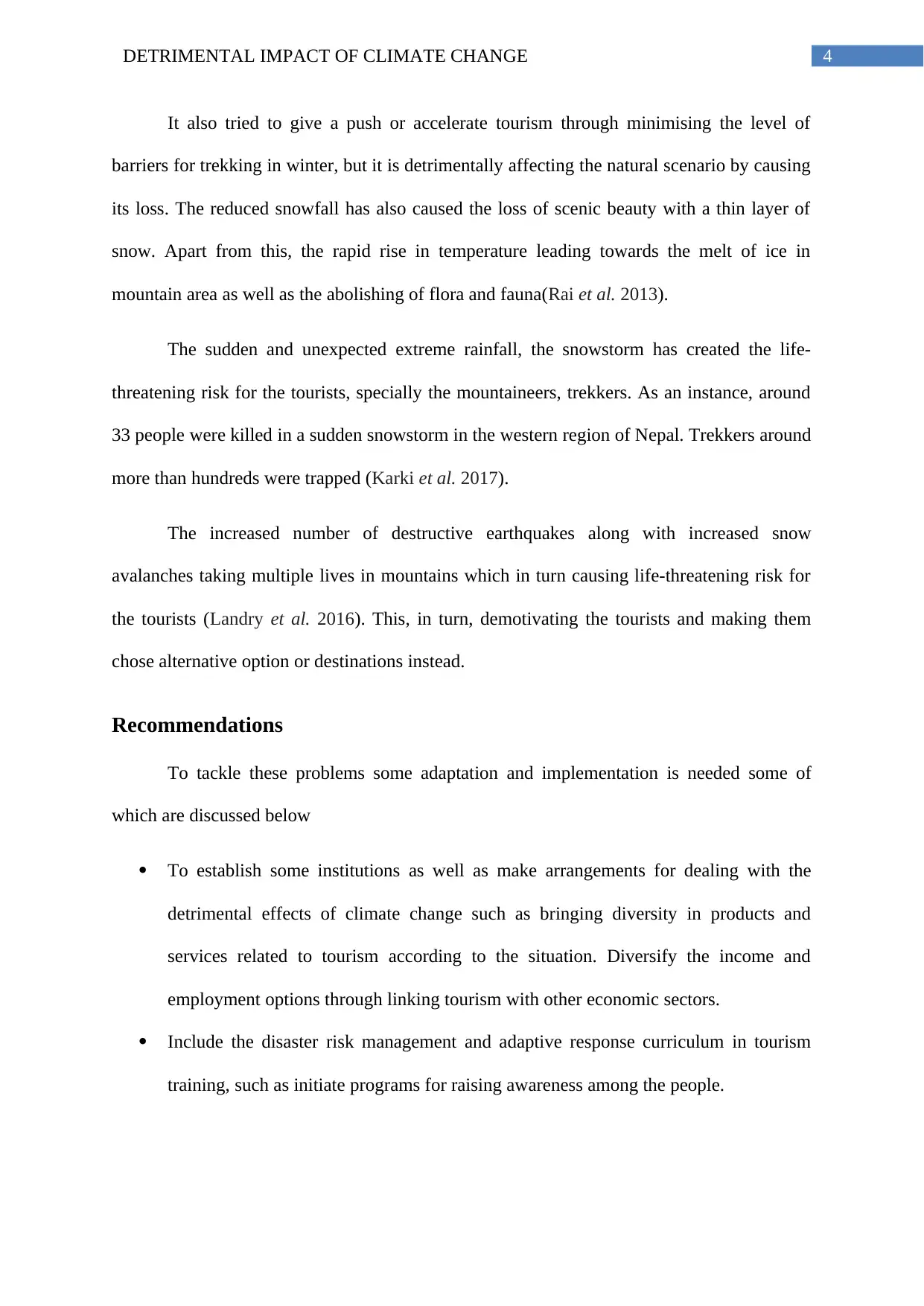
4DETRIMENTAL IMPACT OF CLIMATE CHANGE
It also tried to give a push or accelerate tourism through minimising the level of
barriers for trekking in winter, but it is detrimentally affecting the natural scenario by causing
its loss. The reduced snowfall has also caused the loss of scenic beauty with a thin layer of
snow. Apart from this, the rapid rise in temperature leading towards the melt of ice in
mountain area as well as the abolishing of flora and fauna(Rai et al. 2013).
The sudden and unexpected extreme rainfall, the snowstorm has created the life-
threatening risk for the tourists, specially the mountaineers, trekkers. As an instance, around
33 people were killed in a sudden snowstorm in the western region of Nepal. Trekkers around
more than hundreds were trapped (Karki et al. 2017).
The increased number of destructive earthquakes along with increased snow
avalanches taking multiple lives in mountains which in turn causing life-threatening risk for
the tourists (Landry et al. 2016). This, in turn, demotivating the tourists and making them
chose alternative option or destinations instead.
Recommendations
To tackle these problems some adaptation and implementation is needed some of
which are discussed below
To establish some institutions as well as make arrangements for dealing with the
detrimental effects of climate change such as bringing diversity in products and
services related to tourism according to the situation. Diversify the income and
employment options through linking tourism with other economic sectors.
Include the disaster risk management and adaptive response curriculum in tourism
training, such as initiate programs for raising awareness among the people.
It also tried to give a push or accelerate tourism through minimising the level of
barriers for trekking in winter, but it is detrimentally affecting the natural scenario by causing
its loss. The reduced snowfall has also caused the loss of scenic beauty with a thin layer of
snow. Apart from this, the rapid rise in temperature leading towards the melt of ice in
mountain area as well as the abolishing of flora and fauna(Rai et al. 2013).
The sudden and unexpected extreme rainfall, the snowstorm has created the life-
threatening risk for the tourists, specially the mountaineers, trekkers. As an instance, around
33 people were killed in a sudden snowstorm in the western region of Nepal. Trekkers around
more than hundreds were trapped (Karki et al. 2017).
The increased number of destructive earthquakes along with increased snow
avalanches taking multiple lives in mountains which in turn causing life-threatening risk for
the tourists (Landry et al. 2016). This, in turn, demotivating the tourists and making them
chose alternative option or destinations instead.
Recommendations
To tackle these problems some adaptation and implementation is needed some of
which are discussed below
To establish some institutions as well as make arrangements for dealing with the
detrimental effects of climate change such as bringing diversity in products and
services related to tourism according to the situation. Diversify the income and
employment options through linking tourism with other economic sectors.
Include the disaster risk management and adaptive response curriculum in tourism
training, such as initiate programs for raising awareness among the people.
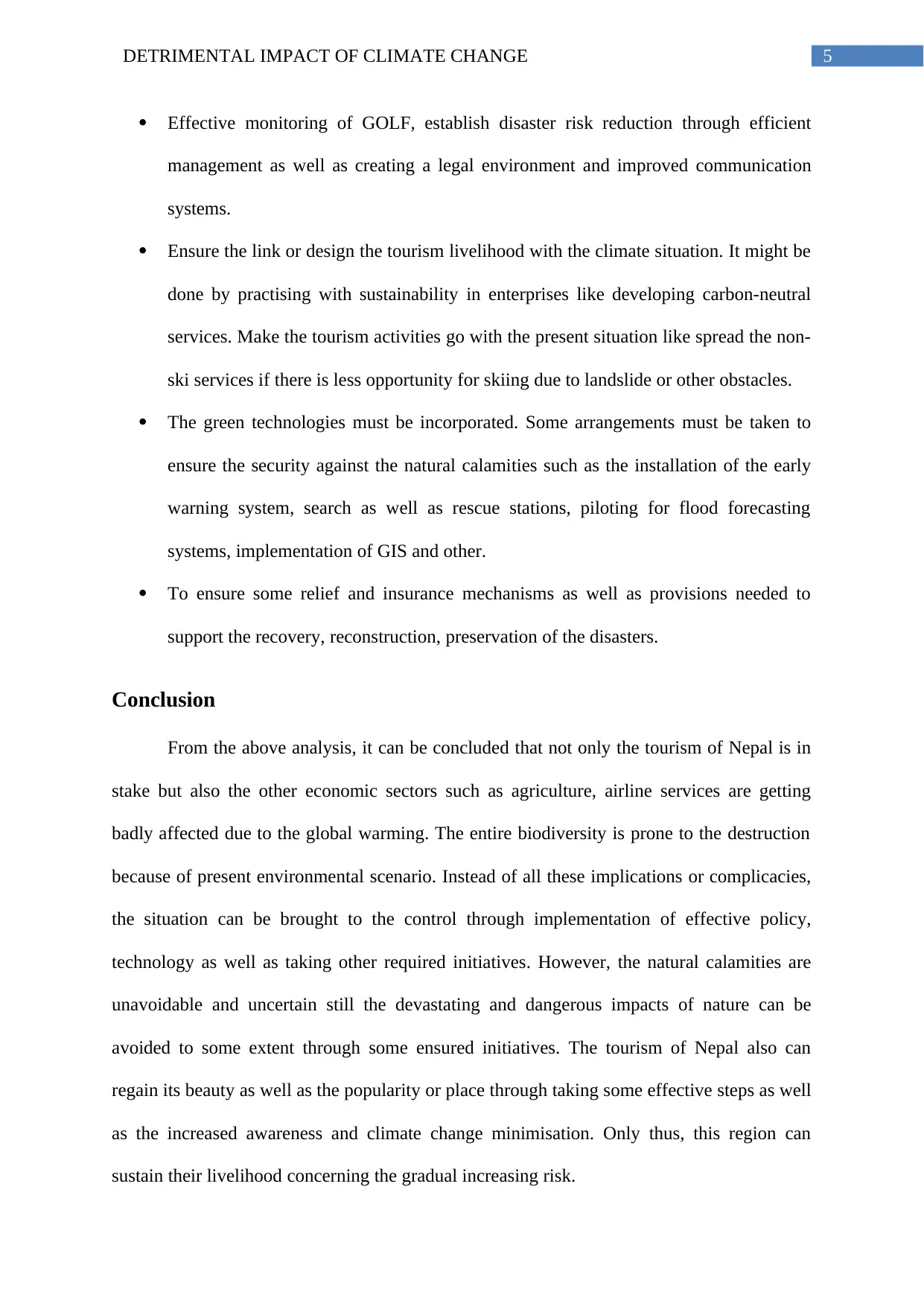
5DETRIMENTAL IMPACT OF CLIMATE CHANGE
Effective monitoring of GOLF, establish disaster risk reduction through efficient
management as well as creating a legal environment and improved communication
systems.
Ensure the link or design the tourism livelihood with the climate situation. It might be
done by practising with sustainability in enterprises like developing carbon-neutral
services. Make the tourism activities go with the present situation like spread the non-
ski services if there is less opportunity for skiing due to landslide or other obstacles.
The green technologies must be incorporated. Some arrangements must be taken to
ensure the security against the natural calamities such as the installation of the early
warning system, search as well as rescue stations, piloting for flood forecasting
systems, implementation of GIS and other.
To ensure some relief and insurance mechanisms as well as provisions needed to
support the recovery, reconstruction, preservation of the disasters.
Conclusion
From the above analysis, it can be concluded that not only the tourism of Nepal is in
stake but also the other economic sectors such as agriculture, airline services are getting
badly affected due to the global warming. The entire biodiversity is prone to the destruction
because of present environmental scenario. Instead of all these implications or complicacies,
the situation can be brought to the control through implementation of effective policy,
technology as well as taking other required initiatives. However, the natural calamities are
unavoidable and uncertain still the devastating and dangerous impacts of nature can be
avoided to some extent through some ensured initiatives. The tourism of Nepal also can
regain its beauty as well as the popularity or place through taking some effective steps as well
as the increased awareness and climate change minimisation. Only thus, this region can
sustain their livelihood concerning the gradual increasing risk.
Effective monitoring of GOLF, establish disaster risk reduction through efficient
management as well as creating a legal environment and improved communication
systems.
Ensure the link or design the tourism livelihood with the climate situation. It might be
done by practising with sustainability in enterprises like developing carbon-neutral
services. Make the tourism activities go with the present situation like spread the non-
ski services if there is less opportunity for skiing due to landslide or other obstacles.
The green technologies must be incorporated. Some arrangements must be taken to
ensure the security against the natural calamities such as the installation of the early
warning system, search as well as rescue stations, piloting for flood forecasting
systems, implementation of GIS and other.
To ensure some relief and insurance mechanisms as well as provisions needed to
support the recovery, reconstruction, preservation of the disasters.
Conclusion
From the above analysis, it can be concluded that not only the tourism of Nepal is in
stake but also the other economic sectors such as agriculture, airline services are getting
badly affected due to the global warming. The entire biodiversity is prone to the destruction
because of present environmental scenario. Instead of all these implications or complicacies,
the situation can be brought to the control through implementation of effective policy,
technology as well as taking other required initiatives. However, the natural calamities are
unavoidable and uncertain still the devastating and dangerous impacts of nature can be
avoided to some extent through some ensured initiatives. The tourism of Nepal also can
regain its beauty as well as the popularity or place through taking some effective steps as well
as the increased awareness and climate change minimisation. Only thus, this region can
sustain their livelihood concerning the gradual increasing risk.
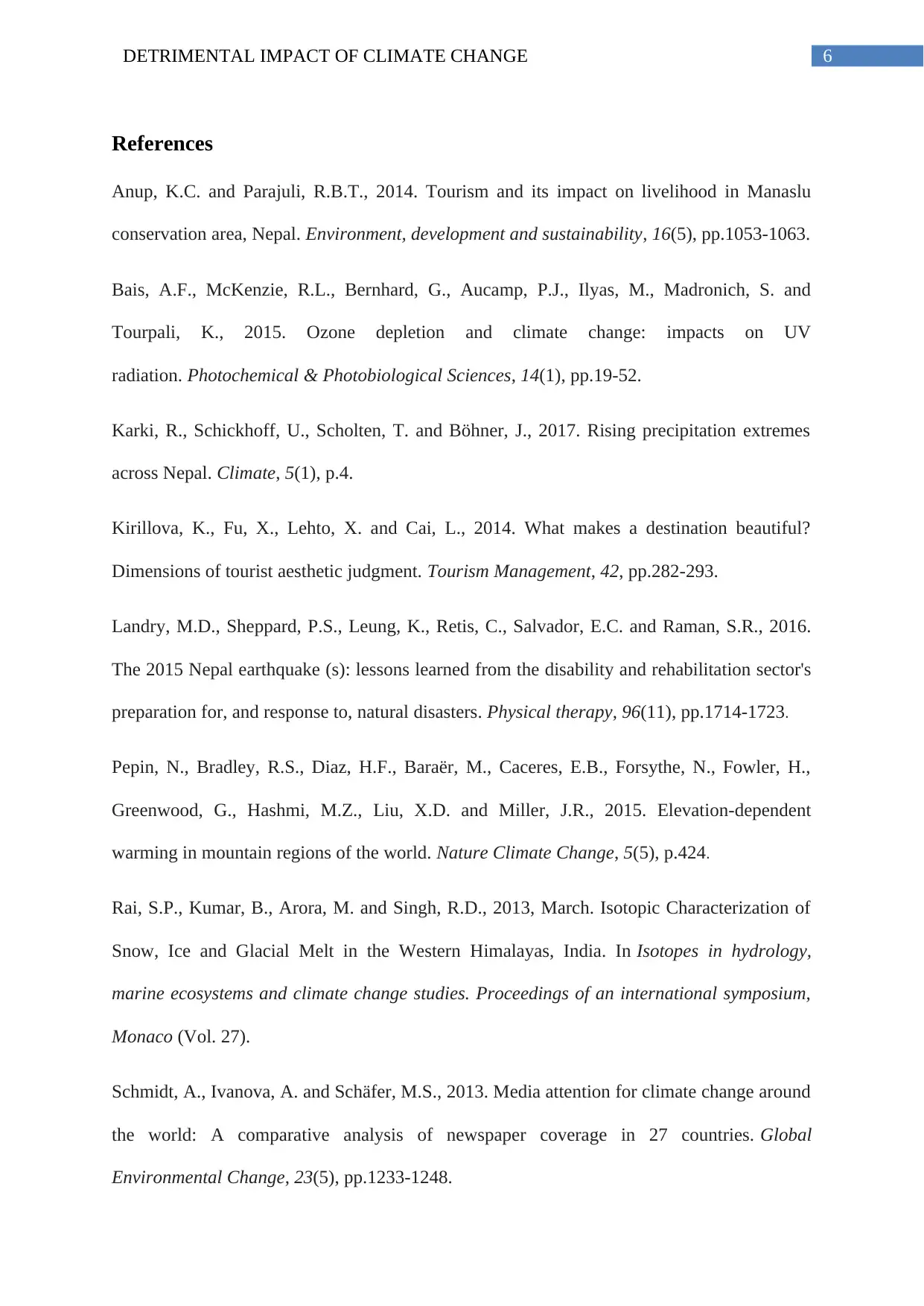
6DETRIMENTAL IMPACT OF CLIMATE CHANGE
References
Anup, K.C. and Parajuli, R.B.T., 2014. Tourism and its impact on livelihood in Manaslu
conservation area, Nepal. Environment, development and sustainability, 16(5), pp.1053-1063.
Bais, A.F., McKenzie, R.L., Bernhard, G., Aucamp, P.J., Ilyas, M., Madronich, S. and
Tourpali, K., 2015. Ozone depletion and climate change: impacts on UV
radiation. Photochemical & Photobiological Sciences, 14(1), pp.19-52.
Karki, R., Schickhoff, U., Scholten, T. and Böhner, J., 2017. Rising precipitation extremes
across Nepal. Climate, 5(1), p.4.
Kirillova, K., Fu, X., Lehto, X. and Cai, L., 2014. What makes a destination beautiful?
Dimensions of tourist aesthetic judgment. Tourism Management, 42, pp.282-293.
Landry, M.D., Sheppard, P.S., Leung, K., Retis, C., Salvador, E.C. and Raman, S.R., 2016.
The 2015 Nepal earthquake (s): lessons learned from the disability and rehabilitation sector's
preparation for, and response to, natural disasters. Physical therapy, 96(11), pp.1714-1723.
Pepin, N., Bradley, R.S., Diaz, H.F., Baraër, M., Caceres, E.B., Forsythe, N., Fowler, H.,
Greenwood, G., Hashmi, M.Z., Liu, X.D. and Miller, J.R., 2015. Elevation-dependent
warming in mountain regions of the world. Nature Climate Change, 5(5), p.424.
Rai, S.P., Kumar, B., Arora, M. and Singh, R.D., 2013, March. Isotopic Characterization of
Snow, Ice and Glacial Melt in the Western Himalayas, India. In Isotopes in hydrology,
marine ecosystems and climate change studies. Proceedings of an international symposium,
Monaco (Vol. 27).
Schmidt, A., Ivanova, A. and Schäfer, M.S., 2013. Media attention for climate change around
the world: A comparative analysis of newspaper coverage in 27 countries. Global
Environmental Change, 23(5), pp.1233-1248.
References
Anup, K.C. and Parajuli, R.B.T., 2014. Tourism and its impact on livelihood in Manaslu
conservation area, Nepal. Environment, development and sustainability, 16(5), pp.1053-1063.
Bais, A.F., McKenzie, R.L., Bernhard, G., Aucamp, P.J., Ilyas, M., Madronich, S. and
Tourpali, K., 2015. Ozone depletion and climate change: impacts on UV
radiation. Photochemical & Photobiological Sciences, 14(1), pp.19-52.
Karki, R., Schickhoff, U., Scholten, T. and Böhner, J., 2017. Rising precipitation extremes
across Nepal. Climate, 5(1), p.4.
Kirillova, K., Fu, X., Lehto, X. and Cai, L., 2014. What makes a destination beautiful?
Dimensions of tourist aesthetic judgment. Tourism Management, 42, pp.282-293.
Landry, M.D., Sheppard, P.S., Leung, K., Retis, C., Salvador, E.C. and Raman, S.R., 2016.
The 2015 Nepal earthquake (s): lessons learned from the disability and rehabilitation sector's
preparation for, and response to, natural disasters. Physical therapy, 96(11), pp.1714-1723.
Pepin, N., Bradley, R.S., Diaz, H.F., Baraër, M., Caceres, E.B., Forsythe, N., Fowler, H.,
Greenwood, G., Hashmi, M.Z., Liu, X.D. and Miller, J.R., 2015. Elevation-dependent
warming in mountain regions of the world. Nature Climate Change, 5(5), p.424.
Rai, S.P., Kumar, B., Arora, M. and Singh, R.D., 2013, March. Isotopic Characterization of
Snow, Ice and Glacial Melt in the Western Himalayas, India. In Isotopes in hydrology,
marine ecosystems and climate change studies. Proceedings of an international symposium,
Monaco (Vol. 27).
Schmidt, A., Ivanova, A. and Schäfer, M.S., 2013. Media attention for climate change around
the world: A comparative analysis of newspaper coverage in 27 countries. Global
Environmental Change, 23(5), pp.1233-1248.
Paraphrase This Document
Need a fresh take? Get an instant paraphrase of this document with our AI Paraphraser
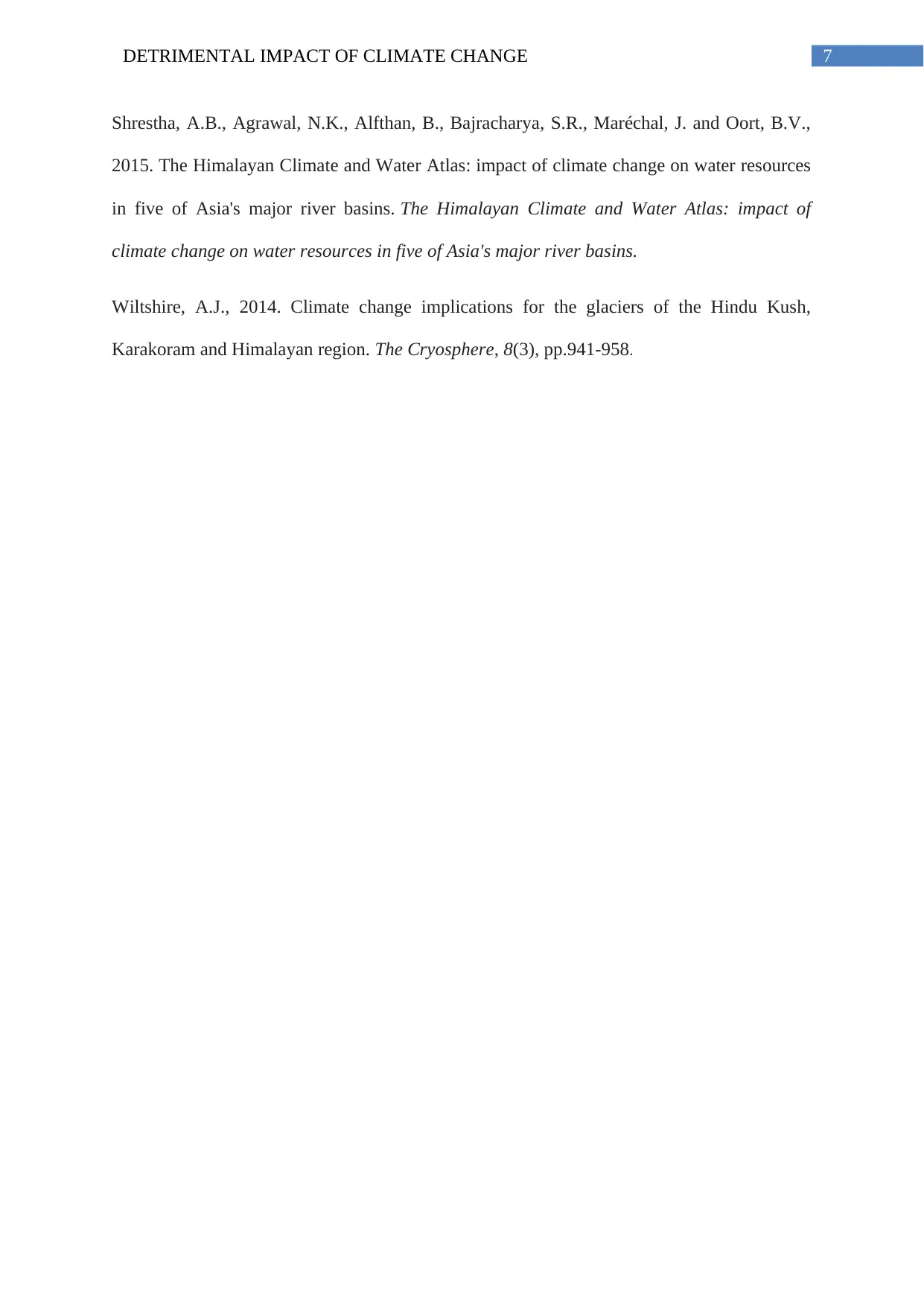
7DETRIMENTAL IMPACT OF CLIMATE CHANGE
Shrestha, A.B., Agrawal, N.K., Alfthan, B., Bajracharya, S.R., Maréchal, J. and Oort, B.V.,
2015. The Himalayan Climate and Water Atlas: impact of climate change on water resources
in five of Asia's major river basins. The Himalayan Climate and Water Atlas: impact of
climate change on water resources in five of Asia's major river basins.
Wiltshire, A.J., 2014. Climate change implications for the glaciers of the Hindu Kush,
Karakoram and Himalayan region. The Cryosphere, 8(3), pp.941-958.
Shrestha, A.B., Agrawal, N.K., Alfthan, B., Bajracharya, S.R., Maréchal, J. and Oort, B.V.,
2015. The Himalayan Climate and Water Atlas: impact of climate change on water resources
in five of Asia's major river basins. The Himalayan Climate and Water Atlas: impact of
climate change on water resources in five of Asia's major river basins.
Wiltshire, A.J., 2014. Climate change implications for the glaciers of the Hindu Kush,
Karakoram and Himalayan region. The Cryosphere, 8(3), pp.941-958.
1 out of 8
Your All-in-One AI-Powered Toolkit for Academic Success.
+13062052269
info@desklib.com
Available 24*7 on WhatsApp / Email
![[object Object]](/_next/static/media/star-bottom.7253800d.svg)
Unlock your academic potential
© 2024 | Zucol Services PVT LTD | All rights reserved.



